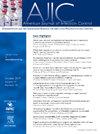一个大型医疗系统中携带莫匹罗星和杀菌剂耐药基因的耐甲氧西林金黄色葡萄球菌(MRSA)的流行情况。
IF 3.8
3区 医学
Q2 INFECTIOUS DISEASES
引用次数: 0
摘要
背景:我们旨在确定住院患者中耐甲氧西林金黄色葡萄球菌(MRSA)分离株中与高水平莫匹罗星和杀菌剂耐药性相关的基因的流行率,并描述其基因组和流行病学特征:方法:在一个综合医疗系统中进行研究。对 2023 年 3 月 1 日至 2024 年 1 月 20 日期间收集的住院患者 MRSA 临床培养物进行了前瞻性全基因组测序(WGS),包括评估是否存在对莫匹罗星(mupA)和杀菌剂(qac)的耐药性标记。我们还回顾了人口统计学和临床特征:我们分析了 463 例 MRSA 分离物。mupA(+)、qacA(+)和 qacC(+)基因的总体流行率分别为 22.0%、2.4% 和 19.0%。大多数 mupA(+) 分离物属于 ST8,但 ST8732(ST8 的新型变种)的 mupA(+) 分离物感染率最高,达到 95%。mupA(+)患者年龄较大,而来自儿童患者的分离株中没有一个携带该基因:讨论:通过对 MRSA 分离物进行前瞻性 WGS 检测,我们发现赋予莫匹罗星耐药性的基因的流行率大大高于之前的报道,尤其是在 MRSA ST8 变体中:我们的研究结果强调了监测用于预防金黄色葡萄球菌感染的药物耐药性的必要性,因为这些趋势对感染预防计划和整个公共卫生都有影响。本文章由计算机程序翻译,如有差异,请以英文原文为准。
Prevalence of methicillin-resistant Staphylococcus aureus (MRSA) harboring mupirocin and biocide resistance genes in a large health care system
Background
We aimed to determine the prevalence of genes associated with high-level mupirocin and biocide resistance in methicillin-resistant Staphylococcus aureus (MRSA) isolates among hospitalized patients and to characterize their genomic and epidemiologic features.
Methods
Study conducted on an integrated health system. Clinical cultures with MRSA from hospitalized patients collected between March 1, 2023, and January 20, 2024 underwent prospective whole-genome sequencing, including assessment for the presence of markers of resistance against mupirocin (mupA) and biocides (qac). Demographic and clinical characteristics were reviewed.
Results
We analyzed 463 MRSA isolates. The overall prevalence of mupA(+), qacA(+), and qacC(+) genes was 22.0%, 2.4%, and 19.0%, respectively. Most mupA(+) isolates belonged to ST8, but ST8732 (a novel variant of ST8) had the highest prevalence of mupA(+) isolates at 95%. Patients mupA(+) were older, and none of the isolates from pediatric patients harbored this gene.
Discussion
Through prospective whole-genome sequencing of MRSA isolates, we detected a prevalence of genes conferring mupirocin resistance considerably higher than previously reported, particularly among MRSA ST8 variants.
Conclusions
Our findings highlight the need for monitoring resistance to agents used for the prevention of S aureus infections, as these trends have implications for infection prevention programs and public health at large.
求助全文
通过发布文献求助,成功后即可免费获取论文全文。
去求助
来源期刊
CiteScore
7.40
自引率
4.10%
发文量
479
审稿时长
24 days
期刊介绍:
AJIC covers key topics and issues in infection control and epidemiology. Infection control professionals, including physicians, nurses, and epidemiologists, rely on AJIC for peer-reviewed articles covering clinical topics as well as original research. As the official publication of the Association for Professionals in Infection Control and Epidemiology (APIC)

 求助内容:
求助内容: 应助结果提醒方式:
应助结果提醒方式:


